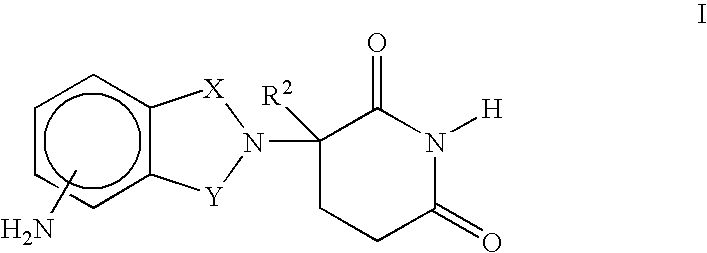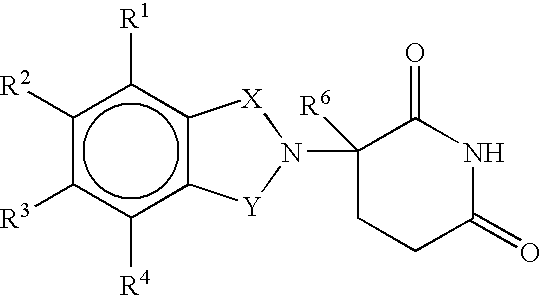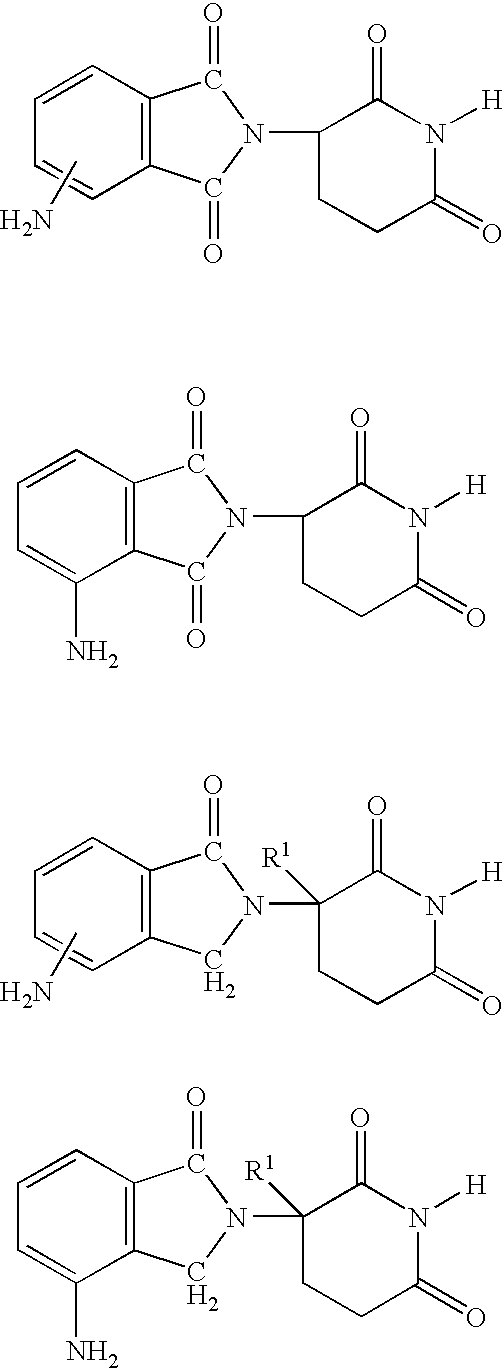Methods and compositions for the treatment, prevention or management of dysfunctional sleep and dysfunctional sleep associated with disease
a technology of dysfunctional sleep and composition, applied in the direction of drug composition, immunological disorders, metabolism disorders, etc., can solve the problems of cognitive impairment, daytime sedation, and diminished motor coordination of benzodiazepines, and achieve the effects of reducing the number of side effects, reducing the effect of benzodiazepines, and improving the effect of sleep quality
- Summary
- Abstract
- Description
- Claims
- Application Information
AI Technical Summary
Benefits of technology
Problems solved by technology
Method used
Image
Examples
example 1
5.1 Example 1
Effects on the Sleep EEG of Rats
[0225] This example is designed to demonstrate the effects of 3-(4-amino-1-oxo-1,3-dihydro-isoindol-2-yl)-piperidine-2,6-dione on the sleep EEG of the rat. The animals are 250-275 gram male Sprague-Dawley rats, in whom stainless steel screw cortical EEG electrodes and stainless-steel nuchal EMG electrodes are surgically implanted at least one week before recording. The recordings, of one hour duration, are performed at 8:00 p.m. with the lights on, using a polygraph calibrated to 50 μg. V / 10 mm. and a paper speed of 10 mm / sec. Sleep stages are determined in 30 second epochs according to standard criteria: waking=low amplitude, mixed frequency EEG and high EMG; non REM sleep=high amplitude, low frequency EEG and low amplitude EMG. W. B. Mendelson et al., Pharmacology Biochemistry and Behavior 2: 553-56, 1974. The two parameters tabulated are sleep latency (time from the beginning of recording to sleep onset defined as a least one continuo...
example 2
5.2 Example 2
Effects on the Sleep EEG of Humans
[0226] Six individuals with varying degrees of sleep apnea are studied on two different nights at least 5 days apart. These volunteer subjects are given saline (control) on one night and 3-(4-amino-1-oxo-1,3-dihydro-isoindol-2-yl)-piperidine-2,6-dione on the other night. Once the subjects have fallen asleep as demonstrated by their EEG, they are monitored for 60 minutes without any intervention. One ml volumes of either saline or 3-(4-amino-1-oxo-1,3-dihydro-isoindol-2-yl)-piperidine-2,6-dione are then delivered into the posterior pharynx via a small catheter (2.5 mm outer diameter and placed transnasally) after the subjects have fallen asleep as verified by electroencephalic (EEG) monitoring. For the 60 minutes prior to instillation of saline or 3-(4-amino-1-oxo-1,3-dihydro-isoindol-2-yl)-piperidine-2,6-dione and the subsequent 60 minutes following instillation, sleep stage (I, II, III, IV, or REM) is monitored via EEG, inspiratory an...
example 3
5.3 Example 3
Pittsburgh Sleep Quality Index
[0228] Twelve subjects were treated with 10 mg / day of 3-(4-amino-1-oxo-1,3-dihydro-isoindol-2-yl)-piperidine-2,6-dione orally for 12 weeks. Subjects were seen every 2 weeks until study completion. Subjects were asked to keep a daily sleep diary asking how much interference with sleep (0-10 scale) was experienced. Patients were also asked to complete the Pittsburgh Sleep Quality Inventory (PSQI) at the start of the treatment and ever 4 weeks thereafter, Buysse, DJ et al., Journal of Psychiatric Research, 28 (2), 193-213, 1989.
[0229] The results of the study indicated that the overall sleep quality, the need for sleep medications, and the presence of daytime sleepiness were all significantly improved with 3-(4-amino-1-oxo-1,3-dihydro-isoindol-2-yl)-piperidine-2,6-dione at 10 mg in a 12 week study.
PUM
| Property | Measurement | Unit |
|---|---|---|
| differential scanning calorimetry melting temperature | aaaaa | aaaaa |
| 2θ | aaaaa | aaaaa |
| 2θ | aaaaa | aaaaa |
Abstract
Description
Claims
Application Information
 Login to View More
Login to View More - R&D
- Intellectual Property
- Life Sciences
- Materials
- Tech Scout
- Unparalleled Data Quality
- Higher Quality Content
- 60% Fewer Hallucinations
Browse by: Latest US Patents, China's latest patents, Technical Efficacy Thesaurus, Application Domain, Technology Topic, Popular Technical Reports.
© 2025 PatSnap. All rights reserved.Legal|Privacy policy|Modern Slavery Act Transparency Statement|Sitemap|About US| Contact US: help@patsnap.com



